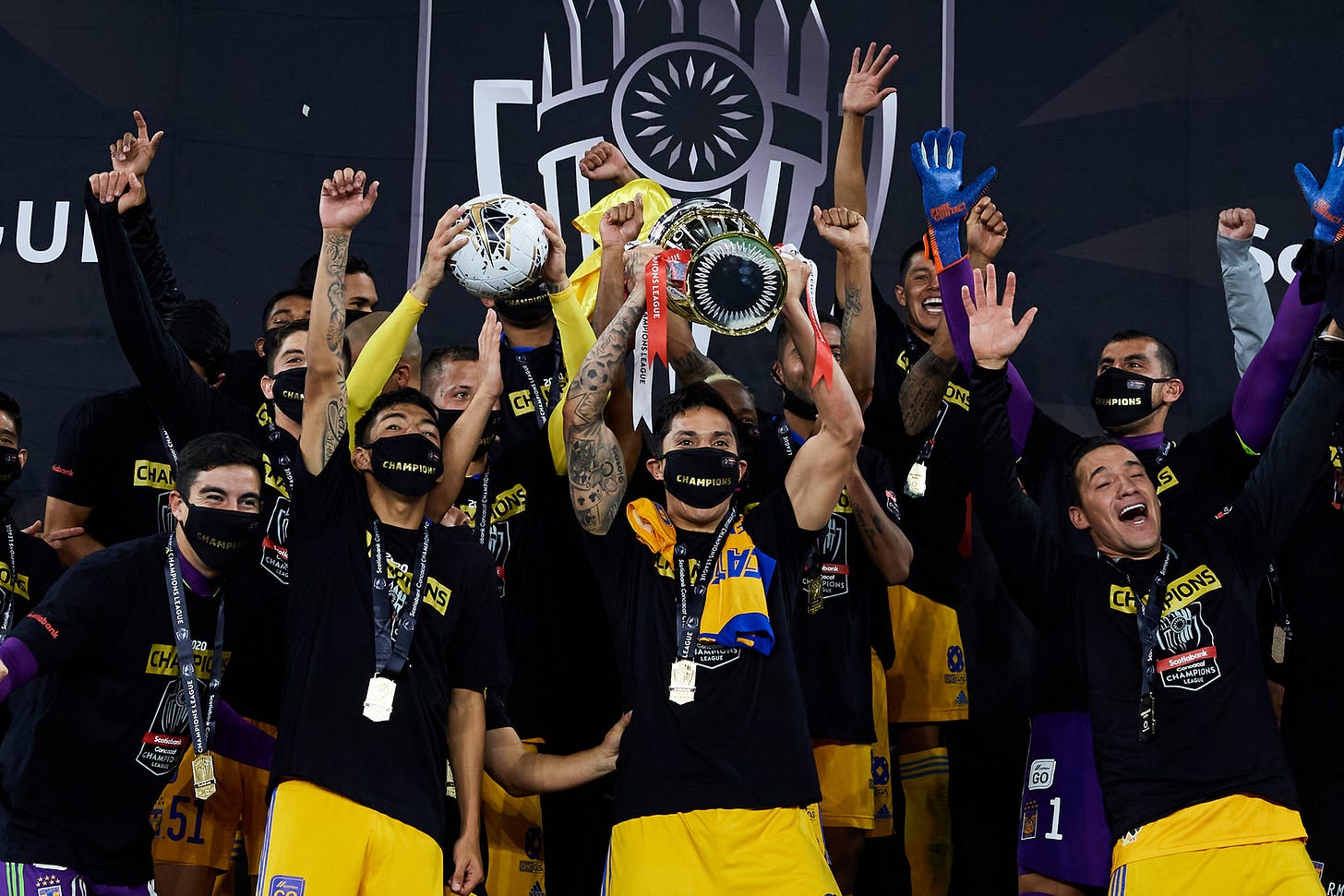🏆 - Another format, rated + the Gold Cup latest
The new CCL format tries to do a lot. Does it succeed?
I started this newsletter at the beginning of the pandemic, and I’ve never been a reporter focused solely on what’s happening on the field of play, so I should’ve known I would be writing a lot about brackets, tournaments and how they work. That said, had I known just how many changes, modifications and new formats would be announced by the powers that be in the region I cover, I would’ve gone with “Soccer Tournament Formats Rated” as the newsletter name rather than “Getting CONCACAFed.”
This week, we again had a diagram (above) and an informational video (below) from federation officials laying out the rules of play, this time for the planned expansion of the Concacaf Champions League, the region’s top club tournament, beginning in 2023-24.
While maybe a little burdensome for Concacaf hardcores like ourselves who get used to the way things are in the region, the number of new formats being rolled out in the region is actually a good thing, generally. There has been, and remains, a risk of stagnation in the region. That’s especially true outside of North America, where the sport’s growth is being pushed forward by a number of entities in the U.S. and Canada, while Mexico looks to continue its dominance as the unquestioned powerhouse on the men’s side of both the club and international game. Keeping things fresh and trying to make sure everyone in the region can improve is a sign Concacaf actually is paying attention to what’s happening on the sporting side and trying to tap in to what its members are looking for.
With the new format, Concacaf is looking to kill not just two but several birds with one stone, and I think there are a lot of dead birds laying around (which, gross). With 20 North American teams starting off in qualification, more teams now have more matches against teams from the rival leagues - potentially lucrative games that should sell well and could lend more prestige depending on matchups and results. They also now have more slots into the 16-team knockout stage, with 11 teams in the final rounds set to come from the North American leagues.

“The Concacaf Champions League has grown impressively in recent years, but this new format will transform the competition and significantly increase its relevance throughout our confederation and globally,” Concacaf President and FIFA Vice President Victor Montagliani said in a news release. “It will elevate clubs and leagues throughout Concacaf with more exciting regional matchups that we know fans want to see. It will also provide a very competitive pathway to the FIFA Club World Cup as clubs from our region strive to succeed on the international stage”
(It’s worth remembering FIFA has plans to expand the Club World Cup, likely moving it to the summer and having a number of teams qualify from each region rather than simply the champion.)
In the Caribbean, just like in international play, club teams need more structure and more matches. With the new Caribbean tournament Concacaf is set to roll out and the Caribbean portion of CCL, there will hopefully be more opportunity for teams to build long-term and aim for a spot in the CCL rather than roll the dice that they can actually get to the Caribbean Club Championship and see what happens. There’s more work to be done here, but at least it’s clear the Caribbean is being thought of - even if there’s only one ticket to the big dance.
Central America is a different case, and I think how teams feel about the new format will depend a lot on what the new Central American tournament looks like. Even though the final was fun this week, it’s never been crystal clear what the point of the Concacaf League is beyond qualifying teams for a bigger tournament (and serving as a gatekeeper so those teams don’t get in and disrupt potential Liga MX vs. MLS matches).
“We are … very excited by the prospect of new Central American and Caribbean Cup competitions as part of this new ecosystem,” Montagliani said. “They will provide great matchups between rival clubs and will further drive development of the club game within the respective regions”.
Starting with 20 clubs there will bring some diversity to a region that is regularly dominated by the usual suspects. Those plan-in matches for the final four spots should be exciting, but there’s no room for error. Is it better than Concacaf League for teams like LDA, Saprissa, Olimpia, Alianza, etc? We’ll see.
Ultimately, the format does a nice job balancing a lot of interests and gives teams some of what they want (namely money) without adding too many games to an already crowded calendar. When we get to the spring, it will feel a lot like the format we’ve gotten used to over the past few years, which is good. I think it’s worked pretty well and given the competition an opportunity to grow both in respect and in quality of product.
All this could change, mostly depending on what the continued flirtation between Liga MX and MLS turns into. If 2020 taught us anything aside from just how many formats can change, it also taught us that nothing is guaranteed when it comes to scheduling and structure of competition. This looks like a good start from Concacaf, but we’ll see what the landscape actually looks like in 2.5 years and how it changes after that.
Get your Gold Cup tickets now?
None of us reading this newsletter have any control over the big-picture of the COVID-19 pandemic (unless, like, Joe Biden or Anthony Fauci signed up with their burner), so in a way we’re all in the same situation. That includes power players at Concacaf like president Victor Montagliani, who, like me, is rooting that the pace of the vaccination rollout happens in the U.S. quickly enough to get fans in the stadium safely for this summer’s Gold Cup.
“Right now I have no doubt it’s going to be played,” Montagliani told TUDN this week.
“It’s going to start July 10, and right now it’s February. The vaccine situation in the United States is getting better every day, and you see other sports, like the Super Bowl, will have fans - not full but something like 25, 30 percent,” the Concacaf president said in Spanish. “I think this percentage is going to start growing and when we get to get to July, we’ll be in a situation where we can have fans - I don’t know about 100 percent but that we’ll be able to have fans at the Gold Cup.”
Gibrán Araige, who conducted the interview, also reports that the Nations League Final Four is set to take place in Chicago with no fans allowed, but that the Gold Cup final will take place with fans in the Raiders new stadium in Las Vegas on August 1.
Fingers crossed that plan is able to function because already modifications are being made for locations of March’s opening matches of World Cup qualification.
More on that next week in the newsletter. See you then.






